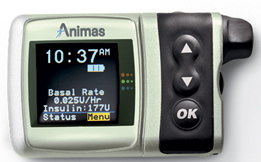 |
| Image graciously stolen from Diabetes Mine |
I'm back on CGM (Continous Glucose Monitoring) Yayyy!
I'm thrilled to say that happened on the 25th November. So I've been using it for two weeks. I had a little hiccup with my pump, which decided to die on the 30th, which made me appreciate the CGM more as it's so helpful the not only know what my blood sugars are but also know where they are going. It was such a relief to see that down arrow.
This time around I feel like I know what I'm doing this time around with this new gadget. The workshop I attended in July presented by author of "Think like a Pancreas", Gary Scheiner entitled "Making Sense of the CGM Data" also helped.
The technology was so new to me in June that I was preoccupied by "how does this thing work?". I was only just getting a handle on having all that extra information by the end of the two weeks. I had been able to upload the information to the software programme and identify trends where I could make some adjustments in my insulin regimen.
But then the trial ended and it was like being blind again.
The major benefit of having a CGM is having this;
 |
| This is the graph from my CGM data. |
and knowing what to do with all those extra data points.
After two weeks, I have been able to prevent a number of lows by my CGM alerting me to the fact that my BG was 4.4mmol/L and dropping. And I've been able to reduce the impact of how high my blood sugar climbs. It's my hope that this will increase how much time I spend within my target blood sugar range of 4 mmol/L to 10 mmol.L (72 mg/dL to 180 mg/dL) overall.
People who have lived with type 1 diabetes since before the 1970's often talk about how access to blood glucose monitors changed diabetes management in a revolutionary way.
I think that the CGM is a game changer for my generation of type 1 diabetes.
Insulin Pump Wizardry
Earlier this year, I started using the EzCarb and the EzBG features on my pump a bit more. Previously, I really only used them for correction insulin doses. I use an Animas Vibe pump and I'm told that on the Medtronic pump this feature is called the Wizard.
Since I've started using this feature I have noticed a reduction in the number of hypos that I have been having.
 Before, I had a tendency not to factor in my Insulin on board, I didn't really have a way to calculate it. Insulin on board is the term used to describe how much insulin is left working in your body from the last bolus and how active it is.
Before, I had a tendency not to factor in my Insulin on board, I didn't really have a way to calculate it. Insulin on board is the term used to describe how much insulin is left working in your body from the last bolus and how active it is.
Also, I would only factor in a correction amount of insulin if I was over 10 mmols/L (180 mg/dL).
I have to say that since using these features I feel like I have reduced the number of hypos that I have. However, I have nothing to back up my theory, it's just a hunch! But it feels nice.
I also like it because it separates out my insulin dose so that I know how much of my insulin is related to the carbohydrate, how much is a blood glucose correction and how much I have to reduce for my Insulin on Board.
Here's to continually making improvements and to tiny triumphs!
Disclaimer: I have not been paid by anybody in relation to this post.
What to Expect At your Diabetes Foot Check
Explaining Type 1 Diabetes to Non Diabetics
So, when I find myself in a situation where I have to explain type 1 diabetes to someone who is not a member of that community, I actually find it extremely difficult. Even when I know it's coming!
Two such encounters have prompted me to try harder in this and I sat down to considered the following;
- when I want to share my diabetes story where is the best place to start (without turning it into a rambling, never-ending tale)?
- And, how do I connect with people who have no connection to diabetes? How do I explain it so that they ask me good questions?
What is type 1 diabetes?
Type 1 diabetes happened to me when my body, for no apparent reason, decided to destroy the part of me that makes insulin.
What the heck is insulin?
Everybody needs insulin to be able to turn the food they eat, namely carbohydrates, into energy. If I don't have insulin, I will die of malnutrition, even though I eat.
 |
| What if, every time you ate any of these foods you had stick a needle into yourself? |
If I just didn't eat carbohydrate would that not make life easier?
A person without diabetes might respond to this with "What if you just didn't eat carbohydrate would that not make life easier?"
Not really, our liver, also, releases glucose and we can't turn that into fuel either. So, we actually have to take insulin to deal with that sugar/glucose that is being continuously released in the background.
So either way, we need to inject/infuse insulin or we die.
What if you just measure how many carbs you are eating against how much insulin you are taking?
One of the ways people manage their with type 1 diabetes is to measure how much insulin they take and measure how much carbohydrate they eat.
Type 1 diabetes is more complex than that. There are other factors that influence blood sugar/glucose (BS). Sure;
- Food brings BS up, but all foods raise BS differently.
- Insulin brings it down.
- ANY physical activity has the potential to bring it up or down.
- Hormones such as adrenaline, the stress hormone cortisol, menstrual hormones can raise or lower your BS.
- Illness raises BS.
Living with type 1 diabetes is tracking all of this and more. It's exhausting!
So all I need now is a guinea pig volunteer to try it out on? Oh and here's some more helpful tips to help explain type 1 diabetes to people.
The HbA1c and how does it fit into Diabetes Management.
 Our HbA1c is just one piece of information in the picture of our diabetes management.
Our HbA1c is just one piece of information in the picture of our diabetes management.
It is really important to our healthcare providers because that's how they measure how well THEY are doing in keeping people with diabetes healthy. It's a global measurement and so they can use it to compare their service to services in other countries.
For us, the individual with diabetes, it really doesn't have that much value. You might feel differently but for me, it's just another number, one of many that I use to manage my type 1 diabetes.
I have had a good HbA1c for a number of years now. But there was a period of time a couple of years ago when I had an excellent HbA1c of 48 mmol/mol (6.5% NGSP unit). However, both myself and my endo were confused because my blood glucose readings told a very different story. They were ALL OVER THE SHOP!!! Not one of my BG readings was within any of my targets!
mmols.
We figured out that I was having more than the occasional hypo during the night and not waking up (Flipping scary). These lows were offsetting the highs during the day, making my HbA1c appear excellent.
These days, I look up my average blood glucose reading over 30 and 90 days on my meter. Plus, I look at my "standard deviation". The Standard Deviation SD is a measure of how spread out my numbers are and it's measured in a percentage.
The SD from the example above is +/-7 which is quite a spread.
Ultimately, I want to smooth out the peaks and troughs of my blood sugars and that's why I would like my average blood glucose reading to be between 8 and 9 mmols and my standard deviation to be a small as possible.
I was always tempted to brag a little about having reasonable HbA1c results. But once I learned about SD it removed all temptation.






